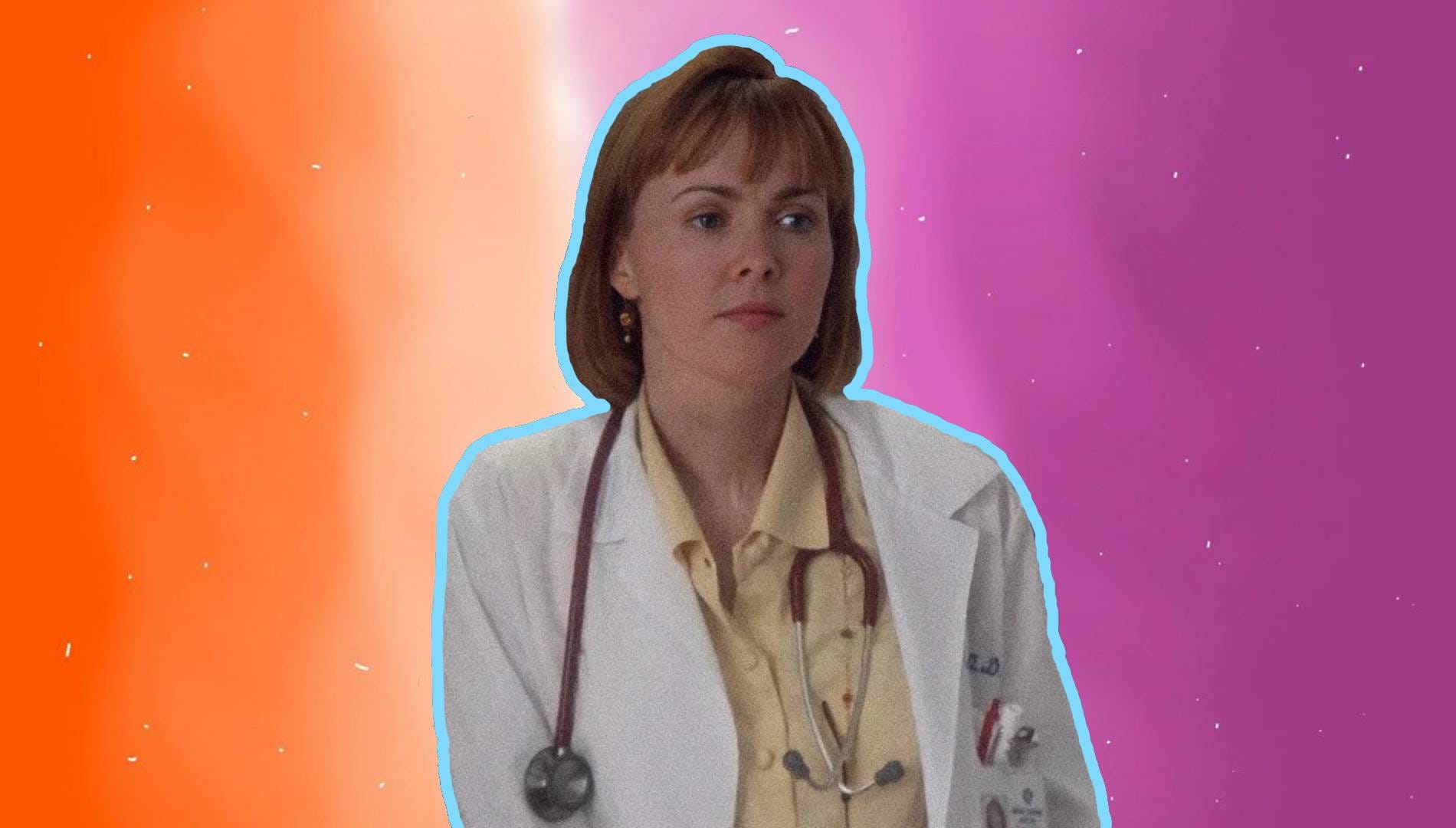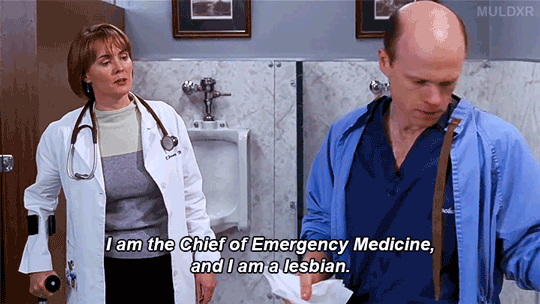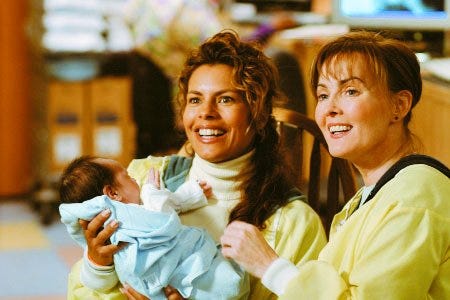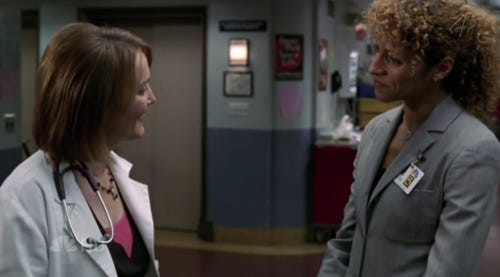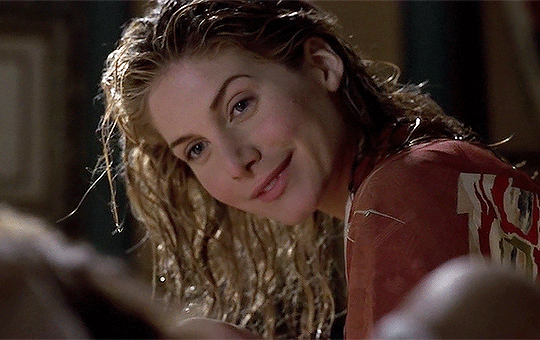Paging Dr. Lesbian - The Lesbian Legacy of 'ER'
This is the Sunday Edition of Paging Dr. Lesbian. If you like this type of thing, subscribe, and share it with your friends. Upgrade your subscription for more, including weekly dispatches from the lesbian internet, monthly playlists, and a free sticker. Editors note: The following contains spoilers for the lesbian storylines on ER, though not any others (in case you feel inspired to watch the show after reading this). Before the sexy intrigue of The L Word or the soapy theatrics of Grey’s Anatomy, there was ER. A humble hospital drama created by Michael Chrichton, the series became a worldwide phenomenon and ran for an impressive 15 seasons. It also featured one of the first lesbian main characters on American television, as well as some groundbreaking storylines about HIV/AIDS. Despite the series’ massive success and envelope-pushing narratives, the show hasn’t stayed in the public consciousness as much as its successor, Grey’s Anatomy (which is still on air after nearly 19 years). No record of lesbian TV history is complete without an account of ER. This is that account. The first season of ER premiered in 1994, the decade that Entertainment Weekly dubbed The Gay 90s. “Gay characters are multiplying on screens big and small,” announced a special report from 1995. The report suggests that gay storylines on TV were now profitable for the first time in history, boosting ratings and garnering (mostly beneficial) publicity. EW conducted a survey of TV watchers and found that most viewers are okay with gay characters on TV, or at the very least simply don’t care. And yet, most of these characters represent brief jaunts into the land of homosexuality, with the titillating “lesbian kiss episode” becoming a trope in the decade. The first lesbian kiss on American TV occurred on L.A. Law in 1991 between the characters C.J. Lamb (Amanda Donohoe) and Abby Perkins (Michele Dominguez Greene). Perkins was straight and Lamb identified as “flexible,” though ended up with a man by the end of that season. Other lesbian kisses in shows like Roseanne and Ally McBeal were provocative one-offs. Ellen’s famous “Puppy Episode” didn’t air until 1997 and Will & Grace premiered in 1998, though its gay characters famously had a lack of romantic storylines. ER was a different beast entirely. Every episode of the fast-paced series takes place over the course of a couple of shifts at County General Hospital in Chicago, as talented doctors and nurses work to save the lives of patients while dealing with a severely underfunded and convoluted healthcare system. The series was an instant hit, with episodes regularly garnering 30 million and even 40 million viewers – ratings that are unheard of today. Throughout 15 seasons, the series featured two lesbian doctors and a handful of gay and trans patients. The first out doctor at County General was Maggie Doyle (Jorja Fox), who joined the series in Season 3. Maggie comes from a family of cops and isn’t afraid to stand her ground, going up against the loathsome Dr. Romano (Paul McCrane) with a sexual harassment claim. After intermittent appearances, Maggie leaves the show in Season 5, presumably because Fox went on to star in a little show called CSI: Crime Scene Investigation.
The longest-lasting lesbian in the series was Dr. Kerry Weaver (Laura Innes), who appeared on the show from seasons 2 to 13, with a special appearance in the finale. When we first meet Kerry, she is a no-nonsense bureaucrat who doesn’t care about being well-liked. This never really changes, but Kerry’s realization about her sexuality affects her behavior in the workplace and how her colleagues – and viewers – see her. Kerry’s coming out journey begins in Season 7, which started airing in 2000. She meets the beautiful and kind-hearted psychiatrist Dr. Kim Legaspi, played by Elizabeth Mitchell. Kim is an out lesbian, and Kerry struggles to accept and be proud of this part of herself, which eventually leads to the dissolution of their relationship at the end of the season. In Season 8, Kerry meets Sandy Lopez (Lisa Vidal), a self-assured firefighter. Kerry is once again fearful of sharing her personal life with her colleagues, but Sandy forces the issue by kissing Kerry in the middle of the hospital. Some of the hospital staff are supportive while others are less so, but everyone is surprised that the stern Dr. Weaver has a heart, after all. Later, Sandy gets pregnant and she and Kerry start a family together, though their happy domestic life is cut short when Sandy dies while on a call. What follows is a heart-wrenching custody storyline (a favorite of ER) where Kerry fights with Sandy’s family to retain custody of her son, Henry. She eventually wins the case, raising Henry as a single mom with help from Sandy’s family. In the 13th season, Kerry meets Courtney Brown (Michelle Hurd), a TV producer. They begin a relationship and Kerry, Henry, and Courtney later move to Miami so Kerry can star in a medical TV segment there. What’s notable about Kerry’s relationships on the show compared to previous iterations of lesbian sexuality is that they are not depicted as flings. When Kerry wakes up in Kim’s bed, or when Sandy and Kerry have their dramatic kiss in the hospital, these are reflections of real, deeply-felt relationships, not titillating ratings grabs. (“Weaver must be so good in bed! All of her girlfriends are so hot,” Innes joked about Kerry’s surprising game.) And yet, Kerry’s sexual identity often fades to the background in episodes where her romantic partners don’t appear, which could be a positive or a negative point depending on your perspective. Much of Kerry’s storyline was steered by Dee Johnson, a lesbian writer on the show. Innes called Johnson a “touchstone” for her and someone she would consult when she had questions or concerns. Johnson told After Ellen that Kerry’s custody battle storyline was inspired by her fear of what might happen with her son if her wife ever passed away. “To call it an agenda is wrong,” she explained. “I just wanted to humanize my life and my relationship. So that was meaningful to me.” Kerry’s coming-out narrative was also a way for the writers to further explore some of the overarching themes of ER. Many of the storylines in the series tease out the tenuous boundary between public and private, as the personal lives of the doctors and nurses threaten to spill over into the workplace. This tension defines the “television work-family,” one of the primary structures of modern television mythmaking. In the early days of Kerry’s coming-out process, the tension between these two modes appears almost entirely incompatible, though she eventually integrates her workplace and personal identities. Every day at County General, these healthcare workers are faced with a near-constant stream of emergencies, and Kerry’s coming-out constitutes another such emergency – albeit on a different register. In “States of emergency: the labors of lesbian desire in ER,” Dana Heller writes that “Weaver’s sexual identity crisis reflects cultural anxieties stemming from the question of lesbianism’s compatibility with the management of one’s own body, and by extension, the question of lesbianism’s compatibility with the care and well-being of the democratic body.” Kerry ruptures the stability (though it is never truly stable) of the ER by bringing up existent debates about gays and lesbians in caregiving positions. When Kerry is distracted by her sexual awakening and fears of being outed, her work suffers. Kerry must learn to take pride in who she is and what she can offer as a doctor and a human being in order to become a productive member of the team again. As Heller puts it, “Her moral illness/sin, however, is not lesbian desire itself, but her earlier denial of its proper relation to the ethic of caring for others and for oneself.” Speaking about Kerry to The Advocate in 2001, Innes affirmed that "The producers emphasized from the beginning to view this as one person falling in love with another person, rather than viewing it in a political, social, or cultural way.” Yet Kerry and her lesbian lovers are necessarily imbued with political ideology, purposeful or not. For example, Heller contends that the show’s writers were able to avoid the “ick factor” of lesbian characters by making Sandy a heroic firefighter. Sandy “represented a new breed of American hero that appeared in the mass media in the aftermath of September 11, 2001,” Heller writes. She is marketable as a hero and became part of a process of American mythmaking in a post-9/11 world. “In these new myths, talented hospital administrators such as Kerry Weaver and dedicated firefighters such as Sandy Lopez become potent defenders of our personal and national security–champions of the endangered child within us all,” says Heller. Viewer responses to Kerry’s coming-out varied, similar to the response she got at County. Though their partnership was relatively short-lived, Kerry and Kim were beloved by lesbian viewers, due in large part to Elizabeth Mitchell’s beauty and charisma. "Women are bigger pigs than men!” Innes joked about the rabid responses Kim galvanized. Kim and Kerry inspired an abundance of fan fiction, fan art, and fan videos, and Kim’s appearance on the show incidentally endowed Kerry with a passionate lesbian fan base. Weavered.com was a popular fan site dedicated to Kerry, and Innes received countless letters from fans detailing how important the character was to them.
On the other hand, Kerry had plenty of haters. Because of her abrasive attitude, Kerry was a divisive character from the start, and for some fans, her coming-out didn’t improve her standing. On fan forums, some viewers argued that Kerry being a lesbian “ruined her character,” that they made her gay to sell more commercials, or that they don’t believe she’s really a lesbian. Innes’ experience interacting with fans confirms some of these opinions. Innes told The Advocate that she often got approached by viewers who, after realizing Innes isn’t gay herself, expressed their true thoughts about Kerry to her. Some of them didn’t believe Kerry was truly a lesbian or expressed “discomfort” and “disappointment” about her being gay. She revealed that the most common homophobic complaint she got from fans was the all-time classic line: "I just don't like it shoved in my face." Such responses indicate that EW’s highly optimistic viewer survey may have underestimated the amount of homophobia embedded in American culture. Nonetheless, Innes remained hopeful about the impact a show like ER could have. She rightly noted that while there were other shows with queer characters on at the time (Queer as Folk and Six Feet Under, for example), none had anywhere near the reach and popularity of ER. Indeed, having a lesbian main character on a show as widely watched as ER (which to be fair, nothing is anymore), is still rare. The power of serial television, particularly one with hundreds of episodes like ER, is the opportunity for fans to invest in these characters. Innes was happy to build that trust with viewers and maybe even change a few minds along the way. “In some ways the viewers are having a relationship with me. They watch me on the show; they knew me before; they know me now. They see I'm still the same. And they see that basically I'm a really good person,” she reasoned. Even twenty years later, the lesbian storylines on ER still feel groundbreaking. In the closing of her article, Heller writes that “Perhaps the greatest emergency that network television shows such as ER will face in their increasing experimentation with queer character development is that coming out constitutes less of a crisis for the lesbian than it does for the society to which she presents herself.” It’s a prescient speculation, as the recent slate of cancellations of LGBT-centric shows indicates that Hollywood is stoking a crisis of sorts where there needn’t be one. A cursory glance and lesbian and queer fandom today indicates that fans are just as passionate about couples like Kim and Kerry as they were in the year 2000, and feel similarly about their broader importance in the world. On the one hand, this seems to demonstrate that not much has changed in the interim. But looking back at this moment in time gives us a better sense of the bricks that were laid to get us to where we are today – the rainbow-colored roads of yore. If nothing else, it’s a reminder to remember our lesbian histories, big and small. You’re a free subscriber to Paging Dr. Lesbian. For the full experience, which includes weekly dispatches from the lesbian internet, become a paying subscriber. Your support means a lot! |
Older messages
5 Lesbian Films You Probably Haven't Seen
Sunday, February 4, 2024
A jaunt around the globe
‘A Murder at the End of the World’ is about resisting domination
Sunday, January 28, 2024
In a sea of Dead Girl Shows, it's a breath of fresh air
The New 'Mean Girls' is Gayer Than The Original, But How Much?
Sunday, January 21, 2024
The answer is complicated
Why Isn't 'The Color Purple' Framed As A Lesbian Story?
Sunday, January 14, 2024
On the new film and the book's complicated journey to the screen
Ask Me Anything #3
Sunday, January 7, 2024
Celebrating Three Years of the Newsletter By Answering Your Questions
You Might Also Like
Sydney Sweeney Debuted A New “Light Suede” Hair Color At The Oscars After-Party
Tuesday, March 4, 2025
Plus, your March astrological forecast, your daily horoscope, and more. Mar. 4, 2025 Bustle Daily Idina Menzel on her new Broadway show. EXCLUSIVE Idina Menzel's New Broadway Show Has One Big
How Worried Should We Be About These Measles Outbreaks?
Tuesday, March 4, 2025
Today in style, self, culture, and power. The Cut March 4, 2025 HEALTH How Worried Should We Be About These Measles Outbreaks? Cases have been popping up across the country. We asked a pediatrician to
Starting Next Week: A New Course on Wordsworth
Tuesday, March 4, 2025
Class starts March 13. Enroll today. Upcoming Literary Seminar: Timothy Donnelly on William Wordsworth Dive into the work of one of England's most influential poets. In this three-session seminar
An update on how Trump’s proposed tariffs could raise food costs
Tuesday, March 4, 2025
A Michelin-starred chef backpedals after disparaging retweets
The Best Memes & Tweets About The 2025 Oscars
Tuesday, March 4, 2025
Plus: Ariana Grande's Oscars performance had a hidden meaning. • Mar. 4, 2025 Up Next Your complete guide to industry-shaping entertainment news, exclusive interviews with A-list celebs, and what
Red Hot And Red
Tuesday, March 4, 2025
What Do You Think You're Looking At? #204 ͏ ͏ ͏ ͏ ͏ ͏ ͏ ͏ ͏ ͏ ͏ ͏ ͏ ͏ ͏ ͏ ͏ ͏ ͏ ͏ ͏ ͏ ͏ ͏ ͏ ͏ ͏ ͏ ͏ ͏ ͏ ͏ ͏ ͏ ͏ ͏ ͏ ͏ ͏ ͏ ͏ ͏ ͏ ͏ ͏ ͏ ͏ ͏ ͏ ͏ ͏ ͏ ͏ ͏ ͏ ͏ ͏ ͏ ͏ ͏ ͏ ͏ ͏ ͏ ͏ ͏ ͏ ͏ ͏ ͏ ͏ ͏ ͏ ͏ ͏ ͏ ͏ ͏
What to Watch For in Trump's Abnormal, Authoritarian Address to Congress
Tuesday, March 4, 2025
Trump gives the speech amidst mounting political challenges and sinking poll numbers ͏ ͏ ͏ ͏ ͏ ͏ ͏ ͏ ͏ ͏ ͏ ͏ ͏ ͏ ͏ ͏ ͏ ͏ ͏ ͏ ͏ ͏ ͏ ͏ ͏ ͏ ͏ ͏ ͏ ͏ ͏ ͏ ͏ ͏ ͏ ͏ ͏ ͏ ͏ ͏ ͏ ͏ ͏ ͏ ͏ ͏ ͏ ͏ ͏ ͏ ͏ ͏ ͏ ͏ ͏ ͏ ͏ ͏
“Becoming a Poet,” by Susan Browne
Tuesday, March 4, 2025
I was five, / lying facedown on my bed ͏ ͏ ͏ ͏ ͏ ͏ ͏ ͏ ͏ ͏ ͏ ͏ ͏ ͏ ͏ ͏ ͏ ͏ ͏ ͏ ͏ ͏ ͏ ͏ ͏ ͏ ͏ ͏ ͏ ͏ ͏ ͏ ͏ ͏ ͏ ͏ ͏ ͏ ͏ ͏ ͏
Pass the fries
Tuesday, March 4, 2025
— Check out what we Skimm'd for you today March 4, 2025 Subscribe Read in browser But first: what our editors were obsessed with in February Update location or View forecast Quote of the Day "
Kendall Jenner's Sheer Oscars After-Party Gown Stole The Night
Tuesday, March 4, 2025
A perfect risqué fashion moment. The Zoe Report Daily The Zoe Report 3.3.2025 Now that award show season has come to an end, it's time to look back at the red carpet trends, especially from last

